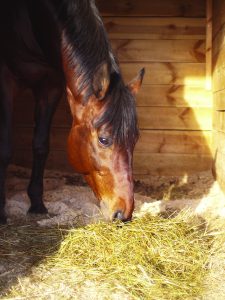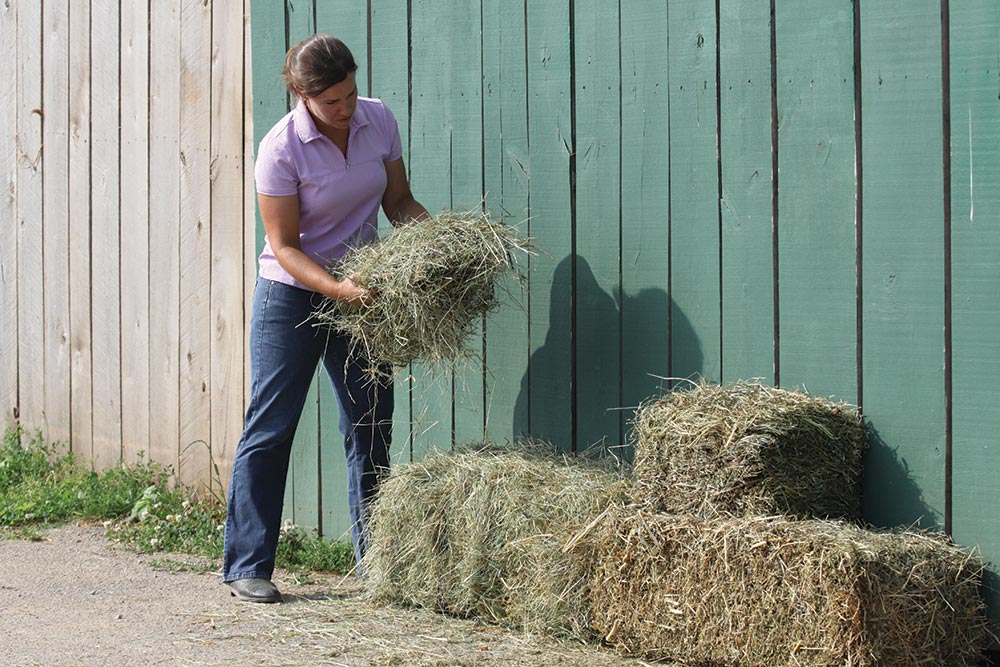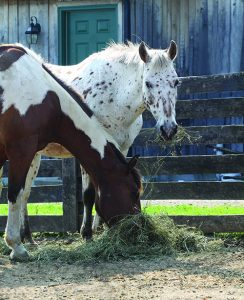
Picture this: It’s hay season in your area—almost time for the first cutting. The grass is already knee-high, the days are long and dry, and farmers are prepping their machines for the work ahead. All of this is good news for you, because it means that your horses will have a fine supply of hay to get them through next winter. But if you’re like many horse owners, you might have only a couple of acres, which your small herd of horses use for grazing. With all of your available cleared land used for pasture, you’re in the same boat as many small-scale horse owners: buying hay and hauling it in from another location.
1. What should I look for?
The exact type of hay you buy will vary from region to region—you’ll find hardy Timothy in many colder regions, but this cool-season grass doesn’t fare as well in warmer or drier climates, where alfalfa, orchard grass, and other types might be more common. Luckily, the basics of buying hay are pretty straightforward, because all quality hay—no matter what specific variety of grass or legumes it contains—shares some of the same attributes.
First, you’ll want to find hay that was stored properly and kept dry after it was cut, but you should also make sure the hay was not rained on in the field during the drying process (despite best efforts, this commonly happens). This can lead to brown, unappealing hay at best and moldy hay at worst.
Good hay retains its best nutritional value if it’s cut at the right point of maturity and not left growing in the field too long, getting over-mature and stemmy. When this happens, the protein levels in the hay drop, while the plant’s indigestible structural fiber (lignin) content increases.
Overdrying can also be a problem. Hay that was overdried may not mold, but it can get dusty, since the fine, leafy materials will be more likely to shatter if they’re too dry.
Ideally, good hay should retain an overall light green color, and the dust content should be low. Finally, quality hay will simply smell nice.

2. Where do I get it?
If you’re lucky enough to live in or close to “hay country”—hooray for you! It makes the job of buying and transporting hay that much simpler, and you may find yourself paying less because of it.
This could be the case if you live in the Midwest, where horse hay is often available within a reasonable distance. If you do live in hay country, here’s one tip to keep in mind: Many hay farmers prefer to sell hay straight off the field. If you can manage to take a delivery of hay shortly after it’s cut (or even help pick it up off the fields yourself), it saves the hay farmer a lot of effort in loading and unloading hay in and out of the barn. You might even be able to negotiate a per-bale discount this way, since your flexibility is saving the farmer time and therefore money. The downside is that you may have to handle and store uncured hay.
In other areas—California or Florida, for example, both of which often import hay from other states—you may have no choice but to buy hay long-distance or from a supplier.
Remember, the hay growing season in your state may differ somewhat from the supplier’s state, so do some research well ahead of time to understand when your hay will be made. Splitting a load with another horse owner or two can help keep costs down, since you’ll be able to buy in bulk but only take home and store the reasonable amount that you require.
3. How will I move it?
If your hay source will deliver the hay to you for a reasonable cost, then consider this option. Hay is heavy, and the equipment required to move large amounts (300+ bales) is expensive and requires experience to drive.
But if you’re planning to haul small amounts of hay (perhaps 50 bales or less), then you have quite a few options. Small trailers designed for hauling machines (like ATVs or riding lawnmowers) are often handy for hay transport, provided you don’t load them past their safe weight rating.
Your (clean) horse trailer can also haul hay in a pinch—the advantage here is that you can utilize a rig you already own. Even the bed of a pickup truck might be sufficient to move 10 or 15 bales if they’re strapped down; this might work if you don’t have far to travel.
4. Where will I store it?

In addition to locating a hay source, many horse owners that are buying hay, then have to solve the puzzle of where to put it. Ideally, you won’t store your hay in the same building with your horses. Even if your stable has some storage space—perhaps in a loft, or a spare stall—this might be better used for storing bedding or other supplies, rather than fresh hay.
The reason is simple: Uncured hay straight off the field represents a potential fire danger, as the excess moisture in the interior of the bales can create a considerable amount of heat until it completely dries out. Provided your hay farmer is experienced and uses a moisture tester to check the moisture content of the hay, this most likely won’t be an issue, but it’s still wise to play it safe anyway.
This curing process can take several weeks. During this time, it’s best to keep the hay in a building separate from your stable. Later on when the hay is fully cured, you could potentially move it in closer to your horses.
But let’s say you have no other option—that spare stall is the only practical hay storage you have. In that case, be sure that the hay you buy has aged well past its cut date before stacking, and plan on stacking the hay loosely, if possible.
Ideally, your hay would be stored in its own dedicated hay barn—a pole building or an older, pre-existing barn on your property. But not everyone has a building like this available to them.
Other options for storing small amounts of hay include small sheds or unused garage bays, providing that these locations are dry but well-ventilated. Fabric shelters or hoop buildings (they look sort of like greenhouses) are inexpensive for the square footage they offer, and can be a decent—though only semi-permanent—hay storage option.
Three-sided sheds and lean-tos are a possibility, but problematic. In good weather these structures may serve as viable hay storage, but the minute you add rain, wind, or snow into the equation, it becomes very challenging to fully protect the hay from moisture. The same holds true for attempts to store hay outdoors on pallets and under tarps—it’s difficult to prevent moisture from destroying the hay, so these systems should be considered a last resort.
If you simply don’t have room to store enough hay for a whole year, you’ll probably have no choice but to haul in small amounts several times annually. If going this route, try to find a hay supplier and develop a good working relationship so that they understand you are going to be a long-term customer.
They may be able to hold hay for you and allow you to pick up small amounts as you need it, which eliminates the need for you to have to store large quantities of hay.
Ideally, try to not bury your remaining hay from the previous year under your new load. Also, be sure to mix in the new hay into your horse’s ration slowly over a few days to avoid an abrupt change in forage.
With your smart shopping and storage strategies, your horse will be enjoying his fresh new quality hay through the season ahead.
This article originally appeared in the July 2019 issue of Horse Illustrated magazine. Click here to subscribe!





